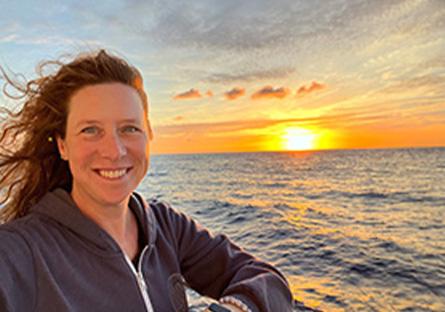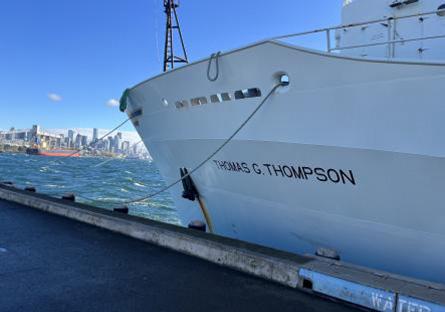

While colleagues and coworkers spent their professional development days in conference centers and lecture halls, Scottsdale Community College (SCC) Professor Dr. Merry Wilson braved thirty-foot waves in the middle of the Pacific Ocean, testing waters for microplastics, measuring plankton concentrations, and sending sonar bouncing off the ocean floor.
Wilson is the Physical Sciences Chair of Geology and Sustainability at SCC. A dry-land geologist with no experience in oceanography or sailing, she said, “For this terrestrial-based life form, it was a lot to deal with. But it became one of the most amazing educational experiences of my life.”
Along with eleven other faculty members from two-year colleges around the country, Wilson embarked on a twelve-day trip aboard a naval research vessel traveling from Seattle to Hawaii. The cohort was selected through a competitive application process by STEMSEAS, which takes advantage of grants from the National Science Foundation to identify and fill open berths on research vessels that are already in service.
Wilson journeyed on the R/V Thomas G. Thompson. The Thompson is a part of the Academic Research Fleet, owned by the Office of Naval Research and operated under a Charter Party agreement by the School of Oceanography at the University of Washington. En route to deliver deep sea seismometers to a team of researchers in American Samoa, STEMSEAS saw the opportunity to inspire a passion for ocean sciences in circles where it would otherwise be inaccessible.
“The hope was that if they trained a bunch of two-year college faculty members to be mentors and showed us that we could do this, then we could volunteer to be mentors for a future voyage and convince our students that they could also succeed in this endeavor,” Wilson explains. “It’s a classic case of ‘Can you see yourself doing this?’ The answer for most two-year faculty and students is ‘No! I’m going to make a fool out of myself! I know nothing about this! I’m going to be so underwater!’”
But after spending the first few days of the voyage in lectures along with engineers, oceanographers, biologists, and fellow geologists, Wilson’s confidence grew. They left their nerves behind with the receding American coast and let their passion for science take over. They allowed themselves to bask in the unknown. They asked seemingly simple questions and used the ship’s highly tuned instruments to find the answers.
“What’s happening right now in the water around us? How do waves work? How does wind speed affect the ocean? What happens to the concentration of plankton as we get farther from land? What kind of changes will we see as we approach Hawaii? What’s the real density of microplastics around the Great Pacific Garbage Patch?”
The cohort explored those questions and more. Wilson got to put her geology expertise to use, too. When storms rocked the Thompson and sent the ship riding up and down towering swells, the cohort realized the challenge of capturing the vessel's movement on camera. Wilson explains it is the same challenge that led to the invention of the seismograph – how can one measure the shaking of the Earth when the instrument is also shaking? Their solution was the same. A rudimentary seismograph made by suspending markers from a rope attached to the ceiling above a sheet of paper allowed them to trace the ship's movement successfully.
Holding up an innocuous-looking rock, Wilson excitedly explains that it’s the fruit of a multi-hour dredging of the sea floor 3,300 meters below the ship. She identifies it as a souvenir of a massive prehistoric landslide that sent a third of modern-day O’ahu plunging into the Pacific, sending tidal waves crashing into the California coast. Her hands are the first ever to touch it.
By the voyage’s end, she felt dwarfed by the seemingly endless expanse of the ocean and the unfathomable density of the life within. “It was this infinite bigness and infinite smallness coming together in one place,” she says.
Wilson involved her SCC students in the experience by sharing their experiments on Instagram. “It made me excited to be a learner again! To have that pure student experience with people who are enthusiastic to learn together. It unlocked a whole new level of professional excitement for me.”
Back in the desert land of Arizona, Wilson is imparting the lessons she learned and encouraging her students to follow in her wake. “You have to push yourself through those barriers that tell you you can’t do something. Because that’s when the payoff is the greatest.”